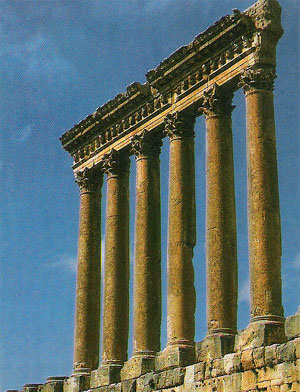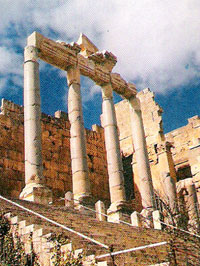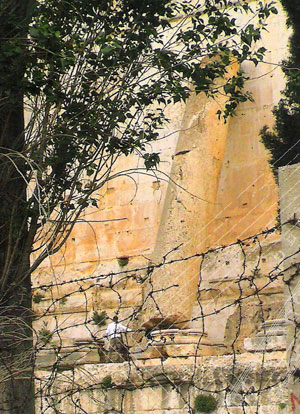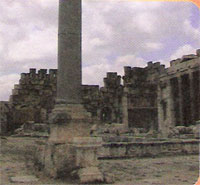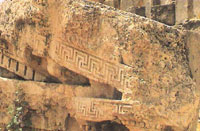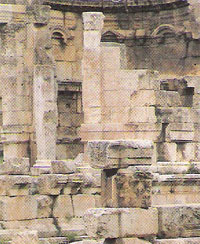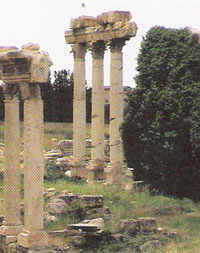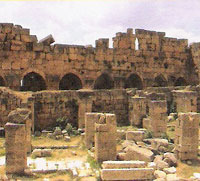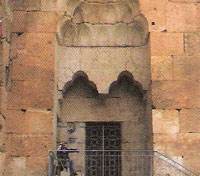Baalbeck, Lebanon's greatest Roman treasure, can be counted among the wonders of the ancient world. The largest and most noble Roman temples ever built, they are also among the best preserved.
Towering high above the Beqaa plain, their monumental proportions proclaimed the power and wealth of Imperial Rome. The gods worshipped here, the Triad of Jupiter, Venus and Mercury, were grafted onto the indigenous deities of Hadad, Atargatis and a young male god of fertility. Local influences are also seen in the planning and layout of the temples, which vary from the classic Roman design.
Over the centuries Baalbeck's monuments suffered from theft, war and earthquakes, as well as from numerous medieval additions.
Fortunately, the modern visitor can see the site in something close to its original form thanks to work in the past hundred years by German, French and Lebanese archaeologists.
Baalbeck is located on two main historic trade routes, one between the Mediterranean coast and the Syrian interior and the other between northern Syria and northern Palestine.
Today the city, 85 kilometers from Beirut, is an important administrative and economic center in the northern Beqaa valley.
The Sights
The temple complex of Baalbeck is made up of the Jupiter Temple and the Bacchus Temple adjacent to it. A short distance away is the circular structure known as the Temple of Venus. Only part of the staircase remains of a fourth temple dedicated to Mercury, on Kheikh Abdallah hill.
The Great Temple or "Jupiter Temple"
The first view the visitor has of Baalbeck is the six Corinthian columns of the Great Temple thrusting 22 meters into the skyline. Built on a podium seven meters above the Court, these six columns and the entablature on top give an idea of the vast scale of the original structure.
The complex of the Great Temple has four sections: the monumental entrance or Propylaea, the Hexagonal Court, the Great Court and finally the Temple itself, where the six famous columns stand.
The Propylaea
The Propylaea completed in the mid-3rd century A.D., is approached by a large semicircle of stone benches and a partially
The Propylaea restored stairway. The entrance structure has towers at either end and is fronted by 12 granite columns. An interior stairway goes to the top of the Propylaea where there is an excellent view of the area.
The Hexagonal Forecourt
Three doors lead to the Hexagonal Forecourt where 30 granite columns originally supported the entablature. This six-sided form was built between the Propylaea and the Great Court in the first half of the 3rd century A.D.
At the end of the 4rth century or the early 5th century, it was covered with a dome and transformed into a church.
The Great Court
Built in the 2nd century A.D., covered an area 134x112 meters and contained the main installation of the cult. Structurally, the court is a platform built on the leveled-off top of the ancient artificial tell. The tell was consolidated on the eastern, northern and southern sides by vaulted substructures, and on the western side by the temple's podium. These substructures supported the porticos and exedrae around the Court and were used for stables and storage.
Two huge structures stand in the center of the Great Court: a restored sacrificial altar and a tower with only the lower courses remaining. The tower, dating from the beginning of the 1st century A.D., was probably built to allow the worshipers to view the proceedings from the top. It was flanked by two solitary columns of gray and red granite. two pools for ritual washing, decorated with relief carvings, were placed north and south of both altar and tower. these structures were destroyed when a Christian basilica was built on the site at the end of the 4th century.
The entire Court was enclosed by a succession of rectangular and semi-circular exedrae or recesses decorated by niches which contained statues. Surrounding the Court, in front of the exedrae, was an 84-column Corinthian colonnade of Egyptian granite. on the exterior walls of the Court the remains of medieval battlements can still be seen.
Temple of Jupiter
After passing through the Propylaea, the Hexagonal Forecourt and Great Court, the worshiper at last arrived at the Temple of Jupiter. This approach to the sanctuary through a series of defined spaces was an apparent oriental adaptation.
The Temple measures 88x48 meters and stands on a podium 13 meters above the surrounding terrain and 7 meters above the courtyard. It is reached by a monumental stairway.
Originally surrounded by 54 external columns, most of these now lie in fragments on the ground. The six standing columns are joined by an entablature decorated with a frieze of bulls and lions' heads connected by garlands.
The Podium is built with some of the largest stone blocks ever hewn. On the west side of the podium is the "Trilithon", a celebrated group of three enormous stones weighing about 800 tons each.
The Little Temple or the "Temple of Bacchus"
Next to the Jupiter complex is a separate building known as the Temple of Bacchus. Constructed during the first half of the 2nd century A.D., it has been remarkably well preserved.
While the Great Temple was dedicated to the public cult of the Heliopolitan Triad, the little temple was apparently consecrated to a mysterious and initiatic cult centered around the young god of Baalbeck. This god was identified as a solar and growth deity, whose birth and growth promised regeneration and eternal life to the faithful.
Wine and other drugs, such as opium, may have been used by the worshipers and it was the carvings of grapes and poppies on the main door jamb and some carved Bacchic scenes, which suggested the temple's identification with Bacchus.
Thirty-three steps lead up to the entrance and the whole structure sits on a platform five meters high. The entrance through the lofty monumental gate and the view of its ornate interior constitute one of the loveliest sights of Baalbeck. The stairs on either side of the doorway may have had some ritual function.
The 15th century tower at the corner of this temple is a good example of the Mamluke fortifications of Baalbeck. From the top of the tower a view can be had of the surrounding area.
The Round Temple or the "Temple of Venus"
The gem-like temple southeast of the acropolis was built in the 3rd century A.D.
Its design and size, as well as its orientation towards the Great Temple, set it apart from the other Baalbeck temples. These attributes also help identify it as the temple of the Fortune of Baalbeck, that is the tutelary divinity of the City, under the protection of its great gods. It was not by accident that during the Byzantine period it was converted into a church dedicated to Saint Barbara, who is the patron saint of Baalbeck to this day.
Near the Temple of Venus are the remains of "The Temple of the Muses", dating from the beginning of the 1st century A.D.
There are a number of other Roman remains and Islamic sites to visit in Baalbeck and its immediate neighborhood.
The Great Omayyad Mosque The Great Mosque
In front of the acropolis entrance, this mosque dates from the 7th-8th centuries of the Omayyad period. Built on what was the site of the Roman forum and later a Byzantine church dedicated to St. John,
the mosque re-uses granite and limestone columns. There is a square minaret in the north-west corner of the courtyard.
Public buildings
At Boustan el-Khan south of the temples are important remains of public baths, a market and probably a bouleuterion, or assembly hall.
Ras El-Ain
This ancient spring, now incorporated into modern Baalbeck, has been a source of water since antiquity. Here are traces of a Roman shrine and nympheun as well as remains of a Mamluke mosque built in 1277.
Quarries
At the southern entrance of town is a quarry where the stones used in the temples were cut. A huge block, considered the largest hewn stone in the world, still sits where it was cut almost 2,000 years ago. Called the "Stone of the Pregnant Woman", it is 21.5m x 4.8m x 4.2meters in size and weighs an estimated 1,000 tons. There is another quarry at Al-Kiyyâl, southwest of town after Qoubbat Douris.
Quoubbat al-Amjad
On Sheikh Abdallah Hill are the remains of the Zawiya - Mosque and tomb of "Sheikh Abdallah Al-Youmînî", built under the rule of Al-Amjad, grand nephew of Saladin and governor of Baalbeck between 1182 and 1230. It was constructed of stones from the neighboring temple of Mercury.
City Gate
Northwest of the Acropolis near the army barracks lie the remains of a Roman city gate, part of the fortifications that surrounded the city.
Qoubbat as-Saadin
Not far from the City Gate is a two-room mausoleum built in 1409, which served as a burial place for the Mamluke governors of Baalbeck.
Qoubbat Douris
At the southern entrance of town is the site of an octagonal structure composed of eight Roman granite columns. Built during the 13th century, it was originally covered with a cupola and held an Ayyoubid tomb.
